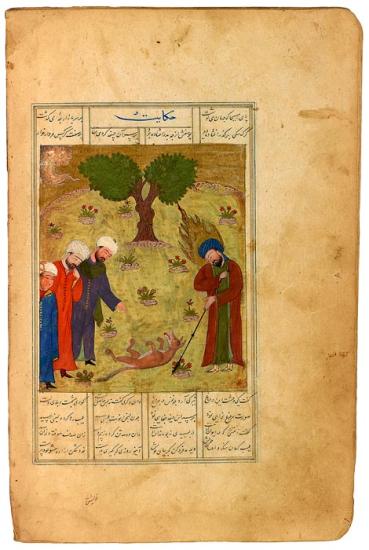Cisa (Jesus) and the Dead Dog

Cisa (Jesus) and the Dead Dog
Khamsa (Quintet), in Persian
Purchased by Pierpont Morgan, 1911
The Makhzan al-asrār (Treasury of Secrets) is the first (ca. 1175) of five long narrative poems making up Niẓāmī's Khamsa (Quintet). Through example, its twenty discourses deal with religious and ethical topics. Here, in an illustration of the tenth discourse, Jesus encounters a dead dog, about which three men make cruel remarks. But Jesus, disregarding faults and finding virtue, tells them that pearls are not as white as the dog's teeth. The moral: do not seek the faults of others and your own merit, but turn your eyes to yourself. The flaming halo denotes Christ as a prophet and saint.
Persian poetry
The Persians loved their poetry and their poets, though the Qur˒an warned against believing their words (sura 69.41) and "those straying in evil who follow them" (sura 26.224). While Arabic was the first language of Islam and the language of the Qur˒an, Persian was favored by poets. Even Firdausī's (940–1020) celebrated Shāhnāma (Book of Kings), the national epic of Persian, was written in verse—some 50,000 couplets! Rūmī (1207–1273), the best known of the Sufi poets, put poetry in perspective when he wrote, "A hundred thousand books of poetry existed / Before the word of the illiterate [Prophet] they were put to shame!" (Masnavī I, 529). Presented here are illustrations of Firdausī's Shāhnāma as well as works by Sa˓ dī (ca.1184–1292), Hāfiz (ca. 1320–1389), and Jāmī (1414–1492), regarded as the last of the great Sufi poets. Also featured are illustrations from each of the five poems of the Khamsa (Quintet), by Niẓāmī (ca. 1141–1209), especially Lailā and Majnūn (The Persian Romeo and Juliet) and Bahrām Gūr's Seven Princesses.